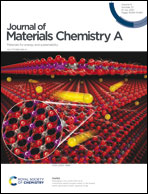Nitrogen and boron coordinated single-atom catalysts for low-temperature CO/NO oxidations†
Abstract
In order to explore the intrinsic properties of single-atom (SA) catalysts, the different kinds of coordinated atoms (typically Bx and Ny) within graphene (BxNy–graphene, x + y = 1–3) can be used to regulate the stability and electronic structure of center metal SAs (BxNy–graphene-SAs) by density functional theory (DFT) calculations. It is found that the SA Co anchored at single vacancy graphene (SV-graphene–Co), B1–graphene–Co and N1–graphene–Co configurations exhibit higher stability than others. The amount of charge transfer between coordinated BxNy and nearest-neighbor carbon atoms can effectively modulate the adsorption stabilities, electronic structures and magnetic properties of central Co atom and reactive gases. Compared to the SV-graphene–Co sheet, the formation of BxNy–graphene sheets can promote the adsorption capabilities for NO and CO; further, the NO and CO oxidation reactions through the Eley–Rideal (ER) and Langmuir–Hinshelwood (LH) mechanisms are comparably investigated. Among these different ratios of coordinated BxNy atoms, the B1–graphene–Co, N1–graphene–Co and B1N1–graphene–Co sheets exhibit good stability and show excellent catalytic activity (<0.5 eV). Therefore, theoretical calculations can provide an in-depth understanding of the structure–performance relationship between coordinated B/N atoms and intrinsic activity of SA catalysts (SACs), which is essential for the precise design of graphene-based SACs and their potential applications.



 Please wait while we load your content...
Please wait while we load your content...